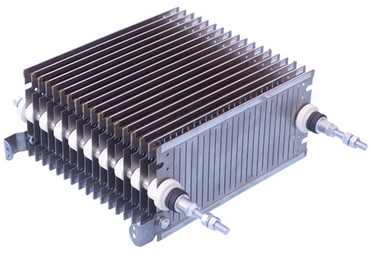
As electrons move through whatever they happen to be moving through at some point in time, be it through a metal wire or the air; if they are not in a complete vacuum they are quite likely to collide with some atom or molecule or perhaps other electrons. Each electron, being objects with mass moving at some velocity, have kinetic energy; as they collide into these particles they lose kinetic energy and the other particle gains kinetic energy. That's usually the end of the story unless some outside force, say that of an electric field, continually does work on the charge and adds kinetic energy to it. The energy gained will then be transferred through constant collisions which will tend to raise the net thermal energy and temperature of the material. These temperature increases from a single electron are laughably small, but in any given circuit there aren't just one, or two, or even twenty electrons; in one Coulomb of charge there are about 6.2415 * 1018 electrons; in one Ampere of current, there are that many electrons, moving through some area, per second. This truly uncountable number of electrons belies a truly uncountable number of collisions, resulting in a noticeable increase in thermal energy relatively quickly.
What "relatively quickly" looks like
In some cases, this thermal energy is desirable, the obvious example being space heaters. In other cases, this thermal energy is waste heat/energy (and thus, waste money) but not a catastrophe. However, most electronic systems these days are composed of many small, delicate parts, and forcing a lot current through them will overheat them, causing smoke or even possibly a small pop and a destroyed component. For comparison, a typical space heater will draw anywhere from 12 A to 15 A of current; your typical small-signal component has an absolute maximum current rating of a few milliamps, or a couple dozen milliamps, or (if they're really hardy) 150 mA. For another example: most small transistors have an absolute maximum voltage rating of 40 V; the typical tube amplifier back in the 1940s would regularly have 100 V across it.
So, for all the miracles they have worked in the modern era, electronics are fragile things compared to how they were back then, so we'd like to have something that can control and reduce the current through the circuit. To construct such a thing, we would take a look at the periodic table to see elements and their valence electron configurations as wall as their ionization energy requirements. In this regard, elements are divided broadly into three categories: insulators, semiconductors, and conductors. An element's (or a compound's) ability to facilitate electron flow is called its conductivity and is given by the equation
σ = [nee2τ]/m
Where ne is the electron density of the substance, e is the charge of an electron, τ is the average time between collisions of the substance (similar to the idea of the mean free path in a gas), and m is the mass of an electron. We then define the resistivity ρ as the inverse of conductivity.
The total resistance of a piece of material then depends on its geometry (its length L and its cross-sectional area A) and its resistivity.
R = [ρL]/A

Any piece of material that is less conductive than the wire used to carry the current can be used as a resistor; some components have been found to work better than others. Perhaps the most familiar resistor is the carbon composition resistor--the one with the color-coded bands on its body indicating the nominal resistance of the resistor. The carbon composition resistor is composed of carbon (which is three orders of magnitude less conductive than most metals) and a ceramic (a good insulator) mixed in with a resin and then painted over; popular colors include beige and blue. Most resistors have a maximum power dissipation rating that limits the maximum safe current through their terminals before they begin to burn; since this current is on the order of a few milliamps, resistors such as wire-wound resistors (which, yes, have some undesirable inductance, being coils) are used to handle large amounts of current, such as those seen by power electronics. The hardiest of all resistor set-ups are grid-resistors (pictured to left) which are grids of metal alloys between two terminals. Such resistors regularly handle 500 A of current. There are also variable resistors, which have a central tap or knob to lengthen or shorten the current path (and in accordance with the resistance equation above, will increase or decrease the resistance).
The unit of resistance is the Ohm, having units of 1 V/A, named for German scientist and school teacher Georg Simon Ohm who formulated Ohm's law in 1827. The unit of conductance is the Siemen, having units of 1 A/V, named for Werner von Siemens, another German industrialist who founded the company Siemens AG. The unit of conductance, being the inverse of resistance, is sometimes called the "mho" which is "ohm" spelled backwards.